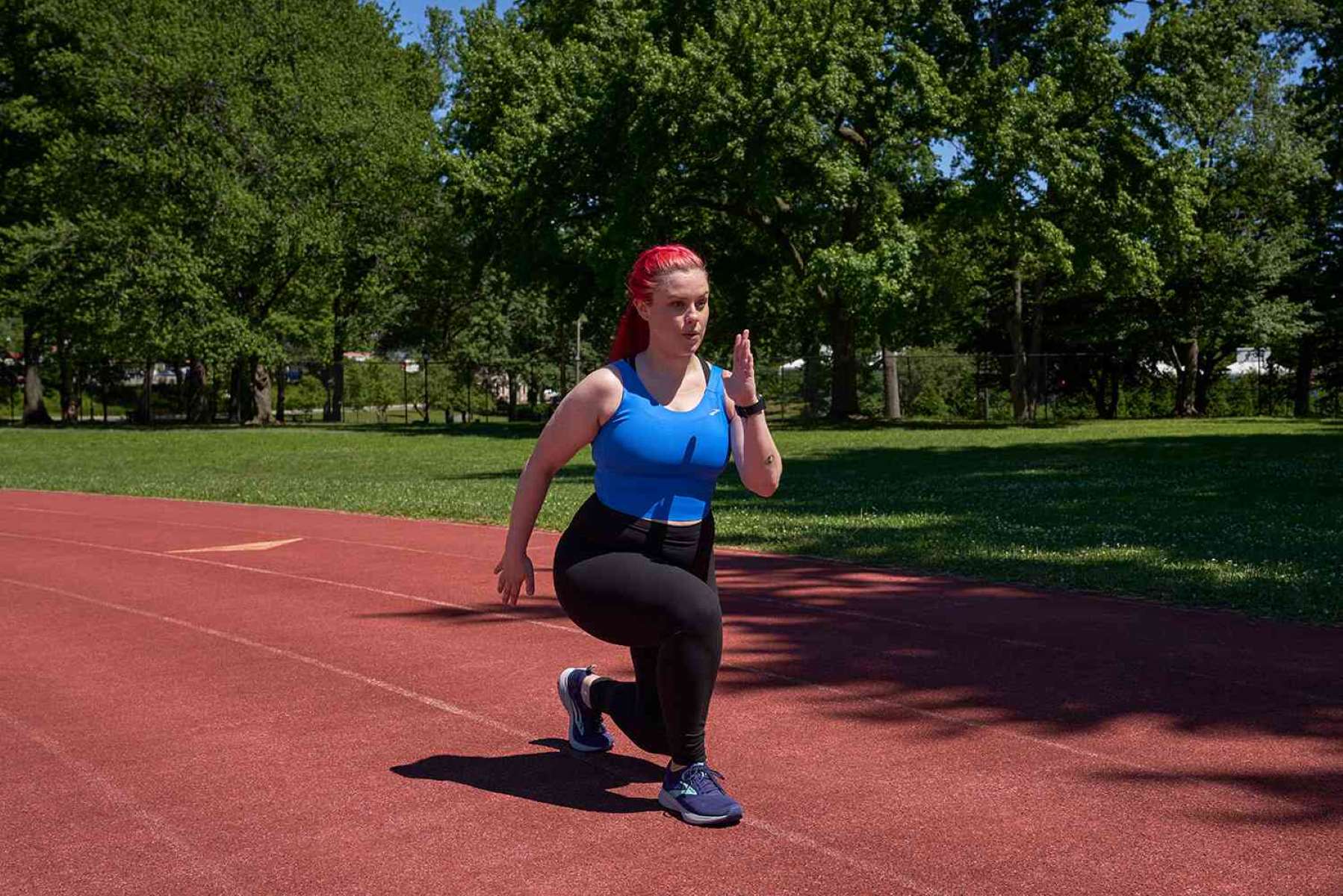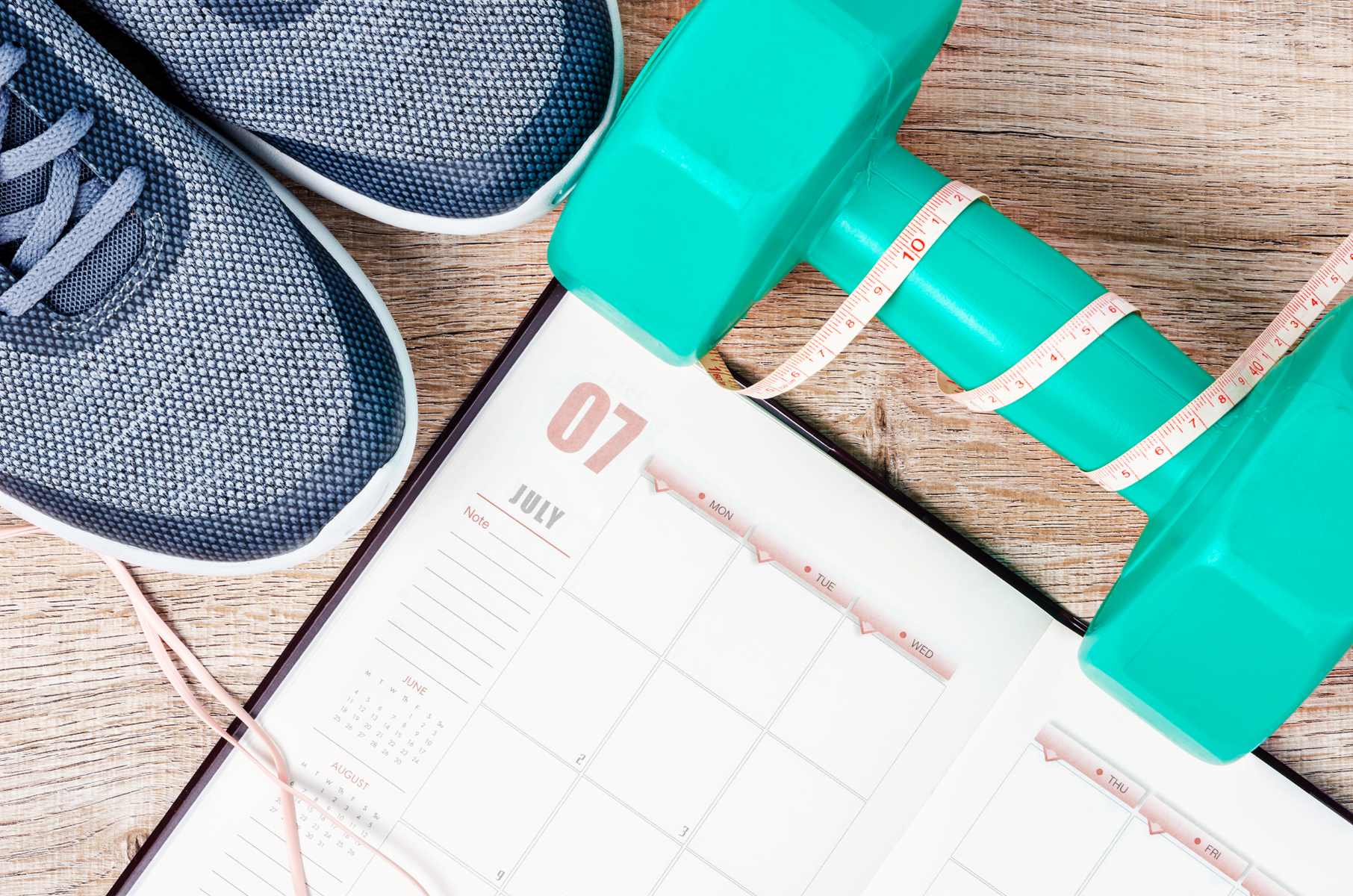

Featured
How To Make An Exercise Plan
Published: October 2, 2023
Discover how to create your own exercise plan with our featured guide. Start building a fitness routine that suits your goals and lifestyle today!
Introduction
Welcome to the world of fitness and exercise! Whether you’re just starting your fitness journey or looking to revamp your current exercise routine, creating an exercise plan is the first step towards achieving your fitness goals. Having a well-structured exercise plan not only helps you stay organized, but it also ensures that you’re targeting the right muscles and making progress towards your desired results.
A properly designed exercise plan takes into account your individual goals, fitness level, time constraints, and available resources. It allows you to focus on specific areas of improvement, such as cardiovascular fitness, strength, flexibility, or overall body composition. With the right plan in place, you can effectively work towards improving your health, increasing your energy levels, and boosting your overall well-being.
In this guide, we will walk you through the process of creating an exercise plan that suits your needs and lifestyle. From setting goals to monitoring your progress, we’ll cover all the necessary steps to help you stay motivated and achieve long-term success.
Remember, creating an exercise plan is not a one-size-fits-all approach. It’s essential to customize your plan based on your individual preferences, abilities, and limitations. This guide will provide you with a framework that can be tailored to your specific needs.
So, let’s get started! By following the steps outlined in this guide, you’ll be on your way to creating an exercise plan that keeps you motivated, challenges you, and helps you achieve the results you desire.
Setting Goals
Before you start creating your exercise plan, it’s essential to set clear and realistic goals. Having specific goals in mind will give you direction and motivation throughout your fitness journey. When setting goals, consider both short-term objectives and long-term aspirations.
Start by asking yourself what you want to achieve. Are you aiming to lose weight, build muscle, increase endurance, or improve overall fitness? Be specific about the changes you want to see in your body or the physical accomplishments you want to achieve.
Next, make sure your goals are measurable. Instead of saying, “I want to get stronger,” you can set a goal like, “I want to increase my bench press by 10 pounds in the next three months.” This way, you can track your progress and celebrate milestones along the way.
When setting goals, it’s also important to make them realistic and attainable. Avoid setting unrealistic expectations that can lead to frustration or injury. Consider your current fitness level, lifestyle, and time constraints. It’s better to start with smaller, achievable goals and gradually progress from there.
In addition to setting specific, measurable, and realistic goals, it’s important to set a timeframe for achieving them. This will help you stay focused and motivated. Breaking your goals down into smaller milestones can also make them feel more achievable and less overwhelming.
Lastly, your goals should be meaningful to you. Reflect on why you want to achieve them and how they align with your values. Having a strong emotional connection to your goals will keep you motivated even when faced with challenges or setbacks.
Remember, setting goals is not just about the end result. It’s also about the journey and the progress you make along the way. Embrace the process, celebrate small victories, and be open to adjusting your goals as needed.
By setting clear and meaningful goals, you establish a roadmap for your exercise plan. These goals will guide your exercise choices, help you stay focused, and propel you towards success.
Assessing Your Current Fitness Level
Before diving into any exercise plan, it’s important to assess your current fitness level. This step helps you understand where you are starting from and allows you to track your progress over time. Assessing your fitness level also helps you choose appropriate exercises and set realistic goals.
There are several ways to assess your fitness level. Here are a few key areas to consider:
- Cardiovascular Endurance: Measure your ability to sustain aerobic exercises like running, cycling, or swimming. You can perform a timed run or see how long you can comfortably maintain a moderate-intensity workout.
- Strength: Assess your strength by performing exercises like push-ups, squats, or lifting weights. Keep track of the number of repetitions or the amount of weight you can lift.
- Flexibility: Evaluate your flexibility by performing stretches and observing your range of motion. Can you touch your toes, or do you have difficulty reaching certain positions?
- Body Composition: Consider measuring your body composition, including body fat percentage and muscle mass. This can be done through various methods like skinfold calipers, bioelectrical impedance analysis, or DEXA scans.
Additionally, it can be helpful to assess other factors such as balance, coordination, and mobility. These aspects of fitness contribute to overall well-being and functionality in daily life.
Keep in mind that assessing your fitness level is not about comparison or judgement. It’s about understanding your starting point so you can track your progress and make informed decisions about your exercise plan. Be honest with yourself and focus on personal improvement rather than comparing yourself to others.
Once you have completed your assessments, document your results and take note of any areas that need improvement. This will guide your exercise choices and help you set realistic goals. For example, if you struggle with cardiovascular endurance, you can prioritize activities like jogging or cycling to improve it.
Remember that fitness is a journey, and your assessments are just a snapshot in time. Repeat your assessments periodically to track your progress and identify areas that may require adjustment in your exercise plan. It’s through regular assessment that you can gauge your improvements and stay motivated.
Choosing the Right Exercises
Now that you have assessed your current fitness level, it’s time to choose the right exercises that align with your goals and capabilities. The key is to find activities that you enjoy and that challenge you appropriately. Here are some factors to consider when selecting exercises:
- Fitness Goals: Consider the goals you established earlier. If you want to improve cardiovascular endurance, activities like running, cycling, or swimming may be suitable. If strength is your focus, weightlifting or bodyweight exercises like push-ups and squats can be effective.
- Preferences: Choose exercises that you enjoy. If you find an activity boring or tedious, you’re less likely to stick with it. Explore different options such as dance classes, hiking, martial arts, or group fitness classes to find what excites you.
- Accessibility: Ensure that the exercises you choose are accessible and convenient. If you have limited access to a gym, consider home workouts or outdoor activities. Look for local facilities, parks, or community centers that offer classes or equipment suitable for your needs.
- Variety: It’s important to incorporate a variety of exercises to engage different muscle groups and prevent boredom. Include activities that focus on cardiovascular fitness, strength training, flexibility, and balance. This variety not only helps you avoid overuse injuries but also ensures a well-rounded fitness routine.
- Progression: As you become comfortable with certain exercises, progressively challenge yourself by increasing the intensity, duration, or weight. This progressive overload helps your body adapt and continue making progress.
Additionally, consider seeking guidance from fitness professionals, such as personal trainers or exercise specialists. They can provide expert advice, instruction, and personalized exercise plans tailored to your goals and fitness level.
Remember to listen to your body. If an exercise causes pain or discomfort, modify it or seek alternatives that are more suitable for your abilities. Safety and injury prevention should always be a priority.
By choosing the right exercises that are aligned with your goals, preferences, and capabilities, you’ll enjoy your workouts more and make consistent progress towards a healthier and fitter you.
Creating a Schedule
Now that you have identified your goals and chosen the right exercises, it’s time to create a schedule that fits seamlessly into your daily routine. A well-structured exercise schedule helps you stay consistent and accountable to your fitness goals. Here are some tips to help you create an effective exercise schedule:
- Time Availability: Assess your daily schedule to determine the best times for exercise. Consider factors such as work, family commitments, and personal preferences. Some people prefer to work out in the morning, while others find evenings more suitable. Choose a time that works best for you and ensures consistency.
- Frequency: Determine how many days a week you can commit to exercise. Aim for a minimum of three to five days to allow your body enough time to recover and adapt. It’s important to find the right balance between challenging yourself and giving your body adequate rest.
- Duration: Decide on the duration of each workout session based on your goals, fitness level, and time availability. Aim for a minimum of 30 minutes per workout session to reap the benefits of cardiovascular exercise, strength training, or a combination of both.
- Variety: Incorporate different types of exercises into your schedule to target various muscle groups and prevent boredom. This can include cardio, strength training, flexibility exercises, and even rest days for recovery.
- Flexibility: Be flexible with your schedule and be prepared to adapt when unexpected events arise. Life happens, and it’s important to have contingency plans for missed workouts. Consider shorter, more intense workouts on busy days or find opportunities for physical activity throughout the day, such as walking during lunch breaks.
- Progression: Gradually increase the intensity, duration, or complexity of your workouts as your fitness level improves. This progression ensures continued improvement and prevents plateauing.
Creating a schedule is not just about the workouts themselves; it’s also about incorporating rest and recovery days. Rest days are crucial for allowing your body to repair, rebuild, and avoid overtraining. Listen to your body’s signals and include rest days in your schedule accordingly.
Write down your schedule and display it where you can easily see it as a reminder and motivator. Remember that your exercise schedule should be realistic and sustainable for the long term. Setting up a routine that you enjoy and can stick to is the key to success.
By creating a well-planned exercise schedule that fits your lifestyle and goals, you’ll be more likely to stay on track towards achieving your desired results and maintaining a healthy, active lifestyle.
Monitoring Your Progress
Once you have started following your exercise plan, it’s important to monitor your progress regularly. Monitoring allows you to track your achievements, identify areas of improvement, and make informed adjustments to your plan. Here are some effective ways to monitor your progress:
- Keep a Workout Journal: Maintain a record of your workouts, including the exercises performed, sets, reps, and weight lifted. This helps you track your progress over time and provides a sense of accomplishment as you see your numbers increase.
- Track Measurements: Take measurements of your body periodically, such as weight, body measurements, or body fat percentage. Tracking these measurements can provide valuable insights into changes in your body composition.
- Monitor Repetitions and Intensity: Pay attention to the number of repetitions or sets you’re able to perform for each exercise. As your fitness level improves, you should see an increase in the number of reps or the amount of weight lifted. Additionally, note the intensity level of your workouts. Are you properly challenging yourself to make progress?
- Use Technology: Utilize fitness apps, wearable devices, or online platforms to track your workouts, monitor heart rate, calories burned, and other relevant fitness metrics. These tools can provide real-time data and help you analyze your progress more accurately.
- Assess Performance: Regularly assess your performance in activities that you enjoy or specific fitness tests related to your goals. Measure improvements in running times, strength gains, or improvements in flexibility. This helps you see tangible evidence of your progress.
- Listen to Your Body: Pay attention to how your body feels during and after workouts. Notice any improvements in energy levels, endurance, strength, or overall well-being. Your body will provide valuable feedback on the effectiveness of your exercise plan.
It’s important to note that progress is not always linear. There may be times when you experience plateaus or setbacks. Be patient and trust the process. Use monitoring as a tool to identify areas for improvement and make necessary adjustments to keep progressing.
Regularly review your progress and celebrate your achievements along the way. This will help you stay motivated and committed to your exercise plan. Remember that progress takes time, and every small step forward is a victory.
By consistently monitoring your progress, you’ll have a clear understanding of how your exercise plan is working for you. This knowledge allows you to make informed decisions and continue refining your plan to achieve your fitness goals.
Making Adjustments
As you progress in your fitness journey, it’s important to recognize that your exercise plan may need adjustments along the way. Making necessary adjustments ensures that your plan remains effective, challenging, and aligned with your goals. Here are some key considerations when it comes to making adjustments:
- Assess Your Progress: Regularly assess your progress to determine if you’re moving towards your goals at a satisfactory pace. If you’re consistently meeting or exceeding your targets, it may be time to increase the intensity or challenge of your workouts.
- Set New Goals: Once you have achieved your initial goals, it’s essential to set new ones to keep yourself motivated and engaged. Continually challenging yourself with new targets helps you avoid complacency and pushes you to new levels of fitness.
- Address Plateaus: If you find that you have hit a plateau where your progress has stalled, it may be time to switch up your routine. Introduce new exercises, vary the intensity or number of sets and repetitions, or try different training methods to break through the plateau.
- Listen to Your Body: Pay attention to how your body responds to your exercise routine. If you experience recurring pain, fatigue, or decreased motivation, it might be a sign that your plan needs adjustment. Consult with a healthcare professional or fitness expert for guidance on modifying your exercise program.
- Consider Time Constraints: Life can sometimes get busy, and your exercise plan may need to be adjusted to accommodate your schedule. If you’re finding it difficult to dedicate a specific amount of time to exercise, consider breaking up your workouts into shorter, more frequent sessions or finding alternative ways to incorporate physical activity into your daily routine.
- Periodization: Incorporate the concept of periodization into your exercise plan, which involves dividing your training into specific blocks or phases. This method allows for variety and targeted training at different intensities, preventing stagnation and optimizing results.
- Seek Professional Guidance: If you’re unsure about how to make adjustments to your exercise plan, it’s beneficial to consult with a qualified fitness professional. They can provide valuable insights, tailor a plan to your needs, and guide you through necessary adjustments based on your progress and goals.
Remember, making adjustments to your exercise plan is a normal and necessary part of the process. Stay open-minded, be willing to try new exercises or training methods, and trust your instincts. Stay in tune with your body and make adjustments as needed to continue progressing towards your fitness goals.
Staying Motivated
Maintaining motivation is key to sticking with your exercise plan and achieving long-term success. Here are some strategies to help you stay motivated throughout your fitness journey:
- Set Meaningful Goals: Continually remind yourself of the reasons why you set your fitness goals in the first place. Whether it’s improving your health, increasing your energy levels, or boosting your self-esteem, keeping your goals meaningful will help you stay motivated.
- Track Your Progress: Regularly monitor and celebrate your progress. Seeing how far you’ve come can inspire you to keep pushing forward. Use visual reminders, such as progress photos or a tracking journal, to reflect on how your hard work is paying off.
- Find an Accountability Partner: Team up with a friend or family member who shares similar fitness goals or values. Having someone to exercise with or check in on your progress can provide an extra level of accountability and support.
- Reward Yourself: Set up a system of rewards for reaching milestones or achieving specific goals. Treat yourself to something enjoyable, like a massage, a new workout outfit, or a relaxing day off. Rewards can help motivate you and make the journey more enjoyable.
- Vary Your Routine: Keep your workouts fresh and exciting by incorporating variety into your exercise routine. Try new exercises, explore different classes or workout styles, or venture outdoors for a change of scenery. Novelty can help combat boredom and keep you engaged.
- Join a Community: Engage with others who share similar fitness interests. Join fitness classes, online communities, or social media groups to connect with like-minded individuals. The support and encouragement from a community of fitness enthusiasts can help keep you motivated and inspired.
- Practice Self-Care: Incorporate self-care activities into your routine, such as getting enough sleep, eating a nutritious diet, and managing stress. Taking care of your overall well-being boosts your energy levels, improves mood, and helps you stay focused on your fitness goals.
- Visualize Success: Use visualization techniques to imagine yourself achieving your goals. Visualize how you feel, look, and perform as you progress on your fitness journey. This positive visualization can increase motivation and help you stay dedicated.
- Stay Positive: Maintain a positive mindset by focusing on your accomplishments and the progress you’ve made, rather than dwelling on setbacks or perceived failures. Surround yourself with positive influences, affirmations, and inspirational quotes to keep your spirits high.
Remember that motivation can fluctuate over time. It’s normal to have ups and downs on your fitness journey. During challenging times, draw on your determination and remind yourself of the reasons why you started.
Ultimately, staying motivated is a personal journey. Find what works for you, experiment with different strategies, and be patient with yourself. The key is to find joy in the process and make fitness a sustainable part of your lifestyle.
Conclusion
Congratulations on taking the first steps towards creating your exercise plan! By setting clear goals, assessing your fitness level, choosing the right exercises, creating a schedule, monitoring your progress, making adjustments, and staying motivated, you are well on your way to achieving your desired fitness outcomes.
Remember that creating an exercise plan is a personalized process. It’s important to listen to your body, be flexible with your schedule, and make adjustments as needed. Stay focused on your goals, but also enjoy the journey and celebrate your achievements along the way.
Keep in mind that maintaining a healthy lifestyle is not just about physical fitness, but also about overall well-being. Take care of your mental and emotional health, practice self-care, and find a balance that works for you.
Don’t forget that progress takes time and consistency. Be patient with yourself, trust the process, and stay committed to your exercise plan. Remember that every small step forward is progress, even if it doesn’t always feel that way.
Lastly, keep the momentum going! Continue exploring new exercises, challenging yourself, and seeking support from others who share your fitness journey. Enjoy the fulfillment that comes from taking care of your body and embracing a healthier and more active lifestyle.
Now, go ahead and put all these guidelines into action as you create your own exercise plan. You have the tools and knowledge to succeed. Good luck on your fitness journey!









